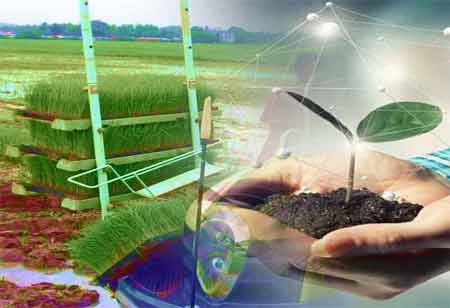Thank you for Subscribing to Agri Business Review Weekly Brief
Transforming Animal Production and Reproduction: Biotechnology's Impact on Studying Physiology, Diet, and Reproduction
Biotechnology is progressively promoting sustainable ways of improving animal husbandry by regulating animal health, nutrition, reproduction, and animal-derived products.

By
Agri Business Review | Tuesday, April 04, 2023
Stay ahead of the industry with exclusive feature stories on the top companies, expert insights and the latest news delivered straight to your inbox. Subscribe today.
Biotechnology improves animal growth, nutrition and reproduction via techniques like MOET, ETT, AI, and in vitro fertilisation, leading to higher productivity and welfare.
FREMONT, CA: Biotechnology is progressively promoting sustainable ways of improving animal husbandry by regulating animal health, nutrition, reproduction, and animal-derived products. Its role in animal physiology and nutrition has been nothing short of impressive.
Animal Physiology and Nutrition
Animal production faces a significant challenge in providing adequate nutrition due to the varying quality and quantity of fibrous animal feed with different levels of digestibility and nutrient values. Animal nutrition experts have developed techniques to improve feed quality, increase digestibility and acceptability, and eliminate anti-nutritive components, particularly for ruminant animals. In addition to feed-based techniques, the most dependable approach to enhance the breakdown of low-quality feeds is by modifying the microbial population in the rumen through alkali treatment, microbial balancing, and genetic engineering.
Animal Reproduction
Artificial Insemination: Artificial insemination (AI) is the most commonly employed biotechnology for animal reproduction, and it has been observed to yield superior genetic progress compared to natural mating. With the advancement of effective semen-freezing techniques, semen collection, dilution, and cryopreservation have become more efficient, allowing a single bull to be used in multiple countries for up to 100,000 inseminations annually. By enabling the widespread utilisation of a few high-quality sires, AI has significantly increased selection intensity. Furthermore, AI has facilitated the implementation of the progeny-testing system, primarily in dairy cattle production, which has greatly improved herd quality by enhancing selection accuracy, despite the associated rise in generation interval.
Embryo Transfer Technology (ETT)
Embryo technology has the potential to make a significant contribution to the research and genetic improvement of local breeds, but it is not currently economically viable for small farms. This technique is primarily applicable to cattle. There are two methods available for producing embryos from donor females. The first involves superovulation, artificial insemination (AI), and then flushing of the uterus to collect the embryos. The second method, called in vitro fertilisation (IVF), involves retrieving eggs from the female's ovaries, maturing and fertilising them outside the body, and then implanting them in foster females. The main advantage of embryo transfer is that it allows for the production of multiple offspring from a single female, similar to how AI produces many offspring from one male animal.
Oocyte Harvesting (OPU), In-Vitro Oocyte Maturation (IVM), and In-Vitro Fertilisation (IVF)
The number of embryos that can be produced from a cow per year is 20 or less using multiple ovulation and embryo transfer (MOET). The development of Oocyte harvesting (OPU) in concurrence with in-vitro oocyte maturation and in-vitro fertilisation, increases by at least 5-fold. However, OPU can be applied to pregnant animals as well as prepubertal animals. The impact of these methodologies on genetic response operates through the same channels as MOET.
Nuclear Transfer or Embryo Cloning
The process of transferring totipotent nuclei into enucleated oocytes has the potential to create clones or identical twins in large numbers. This technique can be used to affect genetic response in various ways such as selection intensity, accuracy, and generation interval. Initially, blastomeres were used as a source for totipotent nuclei, but even with the use of first and higher-order generation blastocysts, the size of the resulting clones remained small. However, the recent development of totipotent embryonic stem (ES)-like cells could significantly increase the efficiency of creating cloned embryos.
Gamete and Embryo Cryopreservation: Many of the techniques discussed are only useful when combined with gamete and embryo freezing methods. Cryopreservation is also essential in conservation programs that aim to preserve genetic diversity.
Biotechnological interventions have been increasingly used in the livestock sector to increase productivity and combat diseases. These interventions range from genetic engineering and genome editing to advanced reproductive technologies and biopharmaceuticals. They have the potential to improve animal health, enhance food safety, and increase production efficiency.
Biotechnology plays a vital role in animal physiology and nutrition as well as reproduction. Biotechnology offers various methods to improve animal health, growth, and development, such as MOET, ETT and in-vitro fertilisation. These methods can help to increase animal productivity, enhance the nutritional quality of animal products, and improve animal welfare. Moreover, biotechnology can also help to overcome some of the challenges associated with animal reproduction, such as infertility, low conception rates, and genetic disorders. Techniques like artificial insemination, embryo transfer, and gene editing can help to improve animal reproduction and produce healthier offspring.





